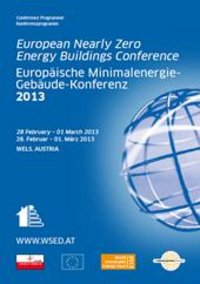PROGRAMME
Thursday, 28 February 2013
14.00 What is a Nearly Zero Energy Building (NZEB)?
- Opening & welcome
Rudi Anschober, Regional Minister for Energy, Upper Austria
Gerhard Dell, OÖ Energiesparverband, Austria
- Update on European building policies
Claudia Canevari, European Commission, DG Energy
- Emerging trends in NZEB definitions
Bogdan Atanasiu, Buildings Performance Institute Europe
- Renewable energy – a key element of any NZEB
Gerhard Dell, OÖ Energiesparverband, Austria
- The impact of NZEBs on EU energy use
Diane Ürge-Vorsatz, Central European University, Hungary
16.30 Selected NZEB technologies
Chairperson: Sorcha Edwards, Power House Nearly Zero Challenge, Housing Europe
- The challenge of designing NZEBs
Adrian Joyce, EuroACE
- Cutting-edge technologies for NZEBs
Hans Erhorn, Fraunhofer Institute of Building Physics, Germany
- Smart cities – intelligent solutions for the future
Michael Paula/Theodor Zillner, Federal Ministry for Transport, Innovation & Technology, Austria
- Demonstration projects of NZEB housing renovation as a vehicle to market development
Maarten De Groote, Flemish Energy Agency, Belgium
- Ventilation in NZEB buildings
Jarek Kurnitski, Tallinn University of Technology, Estonia
18.15 End of the conference day
19.00 Evening programme
Friday, 01 March 2013
09.00 Implementing Nearly Zero Energy Buildings locally and regionally
- Welcome
Christine Öhlinger, OÖ Energiesparverband, Austria
Estelle Delangle, Assembly of European Regions
- Supporting NZEB implementation - the Intelligent Energy Europe Programme
Pau Garcia Audí, European Commission, EACI
- Social housing facing the nZEB Challenge!
Diane Diacon, Building & Social Housing Foundation, UK
- Public buildings: achieving the qualitative and economic objectives
Mel Kendal, County Councillor Hampshire, UK
11.40 Nearly Zero Energy Buildings: Examples and methodologies
- Examples & lessons learned from New England, USA
Thomas RC Hartman/Caroline Petrovick , Coldham & Hartman Architects, USA
- High performance buildings: a feasible option for future cities?
Hans Bloem, European Commission, DG Joint Research Centre
- Testing of energy-efficient building materials
Ilze Dimdiņa, University of Latvia
- Sopharma Business Towers – an innovative office building
Dimitar Panayotov Paskalev, Architectonika Studio, Bulgaria
- Energy efficiency and the market value of properties
Martin Vaché, IWU - Institute for Housing and Environment, Germany
13.00 End of the conference
13.30 - 17.00 Site-visit "Nearly Zero Energy Buildings"
The coming years will see a sharp increase in the market uptake of highly efficient buildings throughout Europe: by 2018, new public buildings must be "nearly zero energy buildings", by 2020, this will apply to all new buildings. According to the European Buildings Directive, a "nearly zero energy building" is a building that has a very high energy performance and the very low amount of energy required is covered to a very significant extent by renewable energy sources. Member States draw up National Plans for increasing the number of nearly zero energy buildings, covering both in new construction and renovation.
The Nearly Zero Energy Buildings Conference offered:
- presentations of criteria for "nearly zero energy buildings" (NZEB) and how this standard can be achieved
- the latest technology trends and financing solutions
- the meeting place for the global sustainable buildings community
- an outlook on the developments on European and global markets for sustainable buildings, including "National Plans for NZEB"
- inspirational case studies and site-visits
- exchange of experience among experts and new business opportunities
- WSED next - an event for young researchers on energy efficiency in buildings
- a major trade show, the “Energiesparmesse“, dedicated to energy efficiency and renewable energy in buildings, with 1,600 exhibitors
Please also see the related conferences:
Upper Austria is an ideal location for such a conference: due to consistent policies, today there are more than 1,000 buildings meeting passive building standard and several thousand near zero energy buildings.
